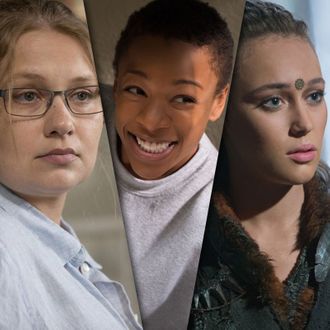
For over 20 years, the good people at GLAAD have been counting the number of LGBTQ characters on television with its annual Where We Are on TV report, and this 2016–17 season was a high watermark for LGBTQ representation. Forty-three of the 895 (4.8 percent) regular characters on broadcast television are gay, lesbian, or bisexual, which is a record high for networks. Of them, ABC had the highest number at 7.3 percent, followed by Fox at 6.4 percent, the CW at 4.3 percent, NBC at 3.9 percent, and unsurprisingly in last place, CBS at 2.2 percent. In general, LGBTQ representation is better on cable and streaming services, with 142 regular and recurring LGBTQ characters on cable and 65 on streaming networks Netflix, Hulu, and Amazon. Overall, there are more queer people, slightly more trans people, and more queer people of color on television than ever before.
It’s important to note that there are significantly more queer people of color on broadcast television (42 percent) than cable (25 percent) or streaming (29 percent). For the most part though, gay men make up the plurality of LGBTQ characters, with just a handful of transgender ones. There are a total of 16 transgender characters on television, up from last year’s seven, with the most notable ones coming from streaming shows like Transparent and Sense8, which feature trans characters as main protagonists (Maura and Nomi, respectively).
Beyond the quantitative data, GLAAD also pointed to the persistent and problematic “Bury Your Gays” trope — that is, the tendency for television shows to kill off their queer characters, usually for the growth and edification of a straight character — particularly as it relates to women. GLAAD reports that 25 lesbian and bisexual female characters died on television since the beginning of 2016, counting Bea Smith (Danielle Cormack) in Wentworth, Cara Thomas (Florence Pugh) in Marcella, and Camila Barrios (Danielle Vega) in East Los High as examples. Indeed, there were a number of other controversial deaths this year, including Merritt Wever’s Denise on The Walking Dead, Alycia Debnam-Carey’s Lexa on The 100, and Samira Wiley’s Poussey on Orange Is the New Black.
“Most of these deaths served no other purpose than to further the narrative of a more central (and often straight, cisgender) character,” writes GLAAD president and CEO Sarah Kate Ellis. “When there are so few lesbian and bisexual women on television, the decision to kill these characters in droves sends a toxic message about the worth of queer female stories.”

